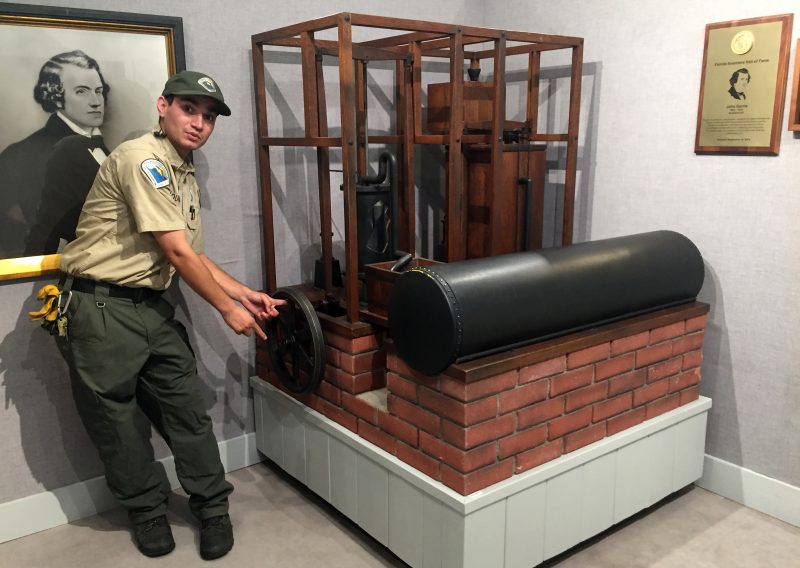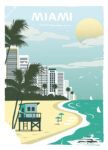Florida air conditioning pioneer first dismissed as a crank
Jeremy Roundtree, Park Ranger for the Florida Park Services, enext to John Gorrie’s (portrait L) ice machine, a mid-19th century forerunner of the modern airconditioner
(Leila MACOR)
Apalachicola (United States) (AFP) – Residents of hot, mosquito-infested Florida know that life there sans air conditioning would be unbearable. Yet the state’s 19th century pioneer in the field was dismissed during his lifetime as a crank.
John Gorrie, a medical doctor who moved to steamy north Florida in 1833 determined to alleviate yellow fever outbreaks, was once described by a New York Globe writer as a crank “who thinks he can make ice by his machine as good as God Almighty.”
Naturally, he died scorned and penniless.
Gorrie’s unrecognized feat, however, lives on in a museum in the Florida panhandle town of Apalachicola, nestled between heavily-forested swamps, debris left over from the last hurricane to hit the region, and spires of the town’s many churches.
Gorrie was a respected member of the community when he first moved to Apalachicola.
He founded its first Episcopal church, “the oldest church today still very valuable to us,” said Jeremy Roundtree, a Florida Park Services ranger at the tiny John Gorrie Museum, the pride of Apalachicola.
“He ran the very first bank out of Pensacola, Florida, he was a postmaster, which was a very lucrative job, he was a mayor here in town.”
But after he made an ice machine and got it patented in 1851, the verdict was: “he’s crazy,” Roundtree told AFP.
– A cure for Yellow Fever? –
The Spaniards, the first Europeans to settle in Florida in the mid 1500s, could never attract enough people to live on the peninsula and eventually ceded the land to the United States in 1819.
Born in 1803, Gorrie spent his sweat-drenched life in Florida searching for ways to create winter with the goal of defeating yellow fever. Outbreaks of the often deadly disease were more terrifying than hurricanes.
The New York-trained doctor quickly linked the yellow fever to heat, but was convinced that it was transmitted by what was known as “swamp gas.”
His solution: cool the patient’s room with machine-made ice.
It took another 50 years for experts to realize that yellow fever was transmitted by mosquitos — which thrive in swamps and die in the cold.
“Which is why today the nation calls him the Father of Refrigeration, and not an amazing doctor,” said Roundtree.
“But he was an amazing doctor, he just finds himself fighting the wrong thing at the right place.”
– The ‘crazy’ ice machine –
Gorrie’s machine is a steam engine with a series of cranks and handles held in a wooden frame on a brick platform that condenses and expand air until, thanks to the thermodynamic cycle discovered just years earlier, it produces ice.
By 1848 the machine was producing 12 blocks of ice a day. Gorrie would put ice inside a bucket that was hung from the ceiling over the patient’s bed or high point near a window.
Hot air, which tends to rise, was thus cooled, and eventually the room temperature — and the patient’s fever — would drop.
Gorrie was far ahead of his time when he patented his machine. Religious Americans, however, were unprepared for a device, clearly inspired by the devil, that could reproduce God’s creation.
“It had nothing to do with God but, instead, science,” Roundtree said. “Which you know today probably doesn’t still walk hand in hand with religion.”
He may have improved the lives of his patients, but Gorrie was unable to sell his ice-making machine.
He died in 1855, mocked and bankrupt.
The first proper air conditioning machine came out about half a century after his death.
“Dr. G came up with a brilliant, far-sighted innovation that helped people, so of course he was labeled a crackpot and died penniless — only to be honored by the state AFTER his death,” said Craig Pittman, a local writer specializing in the offbeat stories that Florida is well known for.
Florida was the least populated US state up to the 1940s. Hotels closed during the summer because of the heat and the clouds of mosquitos the descended on visitors.
It wasn’t until air conditioning became popular and pesticides like DDT came into use in the 1950s that Florida became truly habitable.
“Everyone said he was a crazy man,” said Roundtree.
But today in Apalachicola “as you can see we love and honor Dr. Gorrie because of his sacrifices.”
Disclaimer: Validity of the above story is for 7 Days from original date of publishing. Source: AFP.


